

La minería amenaza a los indígenas shuar en Ecuador – Español. Continue reading the main story Foto El 19 de Febrero, Lenin Moreno, el candidato oficialista del actual presidente Rafael Correa, que ha gobernado el país por una década, no solo no ganó la presidencia en primera vuelta sino que obtuvo sus peores resultados en la Amazonía Sur y en la Sierra Central, las regiones más pobres y con mayor población indígena de Ecuador.
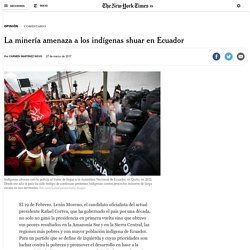
Para un partido que se define de izquierda y cuyas prioridades son luchar contra la pobreza y promover el desarrollo en base a la cosmovisión indígena, esta es una paradoja. En la segunda vuelta del domingo 2 de Abril, el partido indígena Pachakutik apoyará al candidato de oposición Guillermo Lasso, un banquero de derecha. La Confederación de Nacionalidades Indígenas tampoco respaldará al partido de gobierno, Alianza País.
¿Qué explica el desencanto indígena con Correa? WOLA sobre Perú: existe amplia evidencia que esterilizaciones forzadas fueron política de Estado. El caso de las esterilizaciones forzadas fue archivado anteriormente y solo frente a la presión internacional (una resolución de 2011 de la Corte Interamericana de Derechos Humanos) el Ministerio Público lo reabrió.

Lima. Dana declaration. Importance of indigenous resource rights & knowledge. www.un.org/esa/socdev/unpfii/documents/DRIPS_en.pdf. Kari-Oca Declaration. La Declaraci�n Kari-Oca D�claration de Kari-Oca Kari-Oca Declaration The World Conference of Indigenous Peoples on Territory, Environment and Development (25�30 May 1992) Preamble The Indigenous Peoples of the Americas, Asia, Africa, Australia, Europe, and the Pacific, united in one voice at Kari-Oca Villages, express our collective gratitude to the indigenous peoples of Brazil.
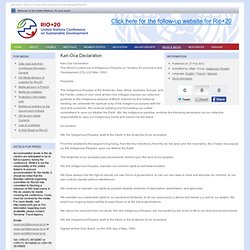
Inspired by this historical meeting, we celebrate the spiritual unity of the indigenous peoples with the land and ourselves. Declaration We, the Indigenous Peoples, walk to the future in the footprints of our ancestors. ENOUGHNESS: Restoring Balance to the Economy. Stunning Portraits Of The World’s Remotest Tribes Before They Pass Away (46 pics. Living in a concrete box with hot water pouring from the tap, a refrigerator cooling our food and wi-fi connecting us to the rest of the world, we can barely imagine a day in a life of, say, Tsaatan people.
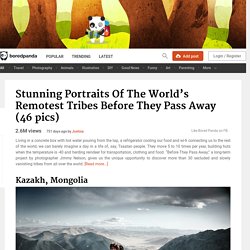
They move 5 to 10 times per year, building huts when the temperature is -40 and herding reindeer for transportation, clothing and food. “Before They Pass Away,” a long-term project by photographer Jimmy Nelson, gives us the unique opportunity to discover more than 30 secluded and slowly vanishing tribes from all over the world. [Read more...] Spending 2 weeks in each tribe, Jimmy became acquainted with their time-honoured traditions, joined their rituals and captured it all in a very appealing way. His detailed photographs showcase unique jewellery, hairstyles and clothing, not to forget the surroundings and cultural elements most important to each tribe, like horses for Gauchos. Source: beforethey.com Book: Amazon.com. Pueblos Indígenas. Mapa: Bolivia / Colombia / Guatemala.
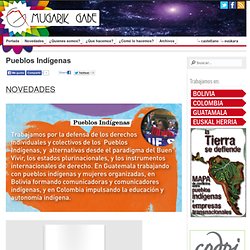
Native American Legal Update : Native American Law : Foster Pepper Law Firm : Northwest, Seattle, Spokane, Portland Lawyer & Attorney. Survival International - The movement for tribal peoples. An Indigenous Led Organization. Amazon tribes. How do they live?
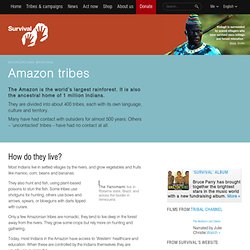
Most Indians live in settled villages by the rivers, and grow vegetables and fruits like manioc, corn, beans and bananas. They also hunt and fish, using plant-based poisons to stun the fish. Some tribes use shotguns for hunting, others use bows and arrows, spears, or blowguns with darts tipped with curare.
Only a few Amazonian tribes are nomadic; they tend to live deep in the forest away from the rivers. They grow some crops but rely more on hunting and gathering. Today, most Indians in the Amazon have access to ‘Western’ healthcare and education. What are their problems? Almost all the Indians’ problems revolve around land: outsiders either want their land, or something on or underneath it. Land = Life Indian tribes whose lands are respected generally thrive.
Indians from Brazil’s Raposa-Serra do Sol indigenous area tell Survival about their lands and lives Take action Amazon tribes need your help. Brazil moves to prevent 'massacre' of Amazon tribe by drug traffickers. The head of Brazil's indigenous protection service is to make an emergency visit to a remote jungle outpost, amid fears that members of an isolated Amazon tribe may have been "massacred" by drug traffickers.
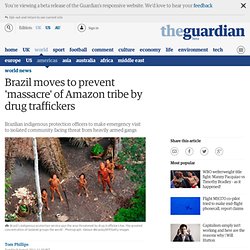
Fears for the tribe's wellbeing have been escalating since late July when a group of heavily armed Peruvian traffickers reportedly invaded its land, triggering a crisis in the remote border region between Brazil and Peru. On 5 August Brazilian federal police launched an operation in the region, arresting Joaquim Antônio Custódio Fadista, a Portuguese man alleged to have been operating as a cocaine trafficker.
But after the police pulled out, officers with the indigenous protection service (Funai) decided to return fearing a "massacre". They claimed that groups of men with rifles and machine guns were still at large in the rainforest. Reports suggest the traffickers may have been attempting to set up new smuggling routes, running through the tribe's land.